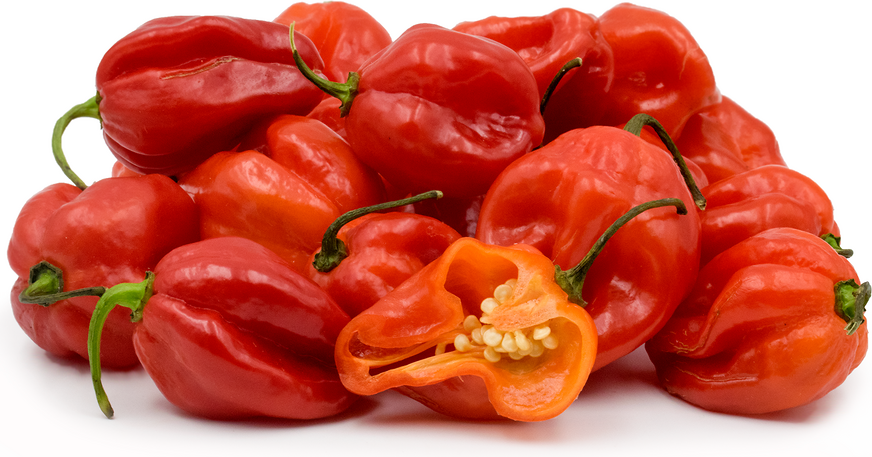


Red Scotch Bonnets Chile Peppers
Estimated Inventory, lb : 0
Description/Taste
Red Scotch Bonnet chile peppers are slightly flattened pods, averaging 5 to 12 centimeters in length and 5 to 8 centimeters in diameter, and have an irregular, bulbous, squat shape with 4 to 5 ridged lobes. The thin, smooth to wrinkled skin has a waxy sheen and transforms from green to red when mature. Underneath the surface, the flesh is pale red to orange, crisp, and aqueous, encasing a central cavity filled with membranes and many small, flat, and round cream-colored seeds. Red Scotch Bonnet chile peppers initially have bright, fruity, and herbaceous flavors mixed with musky notes of tomato, apple, cherry, and bell pepper, followed by intense, pungent heat.
Seasons/Availability
Red Scotch Bonnet chile peppers are available year-round with a peak season in the summer through fall.
Current Facts
Red Scotch Bonnet chile peppers, botanically classified as Capsicum chinense, are a sweet and fruity flavored, spicy pepper that belongs to the Solanaceae or nightshade family. Also known as Bonney peppers, Caribbean Red peppers, Bahama Mama, Scotty Bons, Jamaican Hot, the Bahamian, and the Martinique pepper, Red Scotch Bonnet chile peppers are a very hot cultivar averaging 100,000-350,000 SHU on the Scoville scale. Red Scotch Bonnet chile peppers are distantly related to the habanero pepper and are primarily used in Caribbean cooking, favored for their unusually sweet, tropical flavor mixed with intense heat. The peppers are highly cultivated in Jamaica and are one of the largest agricultural exports for the country. The peppers were also one of the first Caribbean hot peppers to be identified in the export markets by a specific name.
Nutritional Value
Red Scotch Bonnet chile peppers are an excellent source of vitamins A and C, which are antioxidants that can help improve vision, boost collagen production, and can protect the immune system. The peppers also contain magnesium, flavonoids, folate, phytochemicals, and a high amount of capsaicin, which is the chemical compound that triggers the brain to feel the sensation of heat or spice. Capsaicin has been shown to provide anti-inflammatory benefits.
Applications
Red Scotch Bonnet chile peppers are best suited for both raw and cooked applications such as roasting, boiling, or sautéing. The peppers can be sliced or chopped fresh into hot sauces, chutneys, and salsas, or they can be mixed into ceviche. When preparing, the peppers can be used whole and removed at the end of the cooking process to add minimal heat, or they can be sliced, minced, or chopped for the highest amount of spice and flavor. It is also recommended that gloves and goggles are worn when handling the peppers as the high capsaicin content can irritate the skin and eyes. In cooked applications, Red Scotch Bonnet chile peppers can be used to flavor Jamaican jerk meats, fried fish, and pepper shrimp, tossed into soups, stews, and curries, or stirred into rice dishes. They are also widely used in vinegar-based hot sauces to add heat and flavoring to any meal. In addition to cooked applications, Red Scotch Bonnet chile peppers can be dried and ground into a seasoning. Red Scotch Bonnet chile peppers pair well with ground mustard, thyme, cilantro, allspice, carrots, potatoes, pumpkin, green beans, tropical fruits such as mango, papaya, and pineapple, and meats such as fish, pork, beef, goat, and poultry. The fresh peppers will keep 1-2 weeks when stored whole and unwashed in the crisper drawer of the refrigerator.
Ethnic/Cultural Info
Red Scotch Bonnet chile peppers received their name from their resemblance in shape to a Tam O-Shanter hat, also known as a Scotsman’s bonnet. Despite their Scottish name, these peppers are unrelated to Scotland and are one of the most popular peppers in the Caribbean, with Jamaica being the largest producer and exporter. Red Scotch Bonnet chile peppers are synonymous with Jamaican jerk sauces, and it is often said that in Jamaica, when someone mentions a hot chile pepper, they are most likely referring to a Scotch Bonnet chile pepper. In addition to seasonings and hot sauces, the peppers are also used in folk medicine to help with digestion and are believed to help ward off evil spirits.
Geography/History
Scotch Bonnet chile peppers are descendants of original pepper varieties native to the Amazon Basin and have been cultivated since ancient times. The peppers were then introduced into the West Indies via exploration of indigenous populations, and eventually, the island settlements began cultivating the peppers to create new cultivars, like the Red Scotch Bonnet, that would in time become specifically adapted to each island. Today Red Scotch Bonnet chile peppers are grown mainly in the Caribbean on the island of Jamaica as the pepper thrives in the tropical climate in all fourteen parishes of the country. The peppers are used locally and are also exported into the United States, Central America, South America, and Western Africa. Outside of the Caribbean, Scotch Bonnet chile peppers are available through online seed catalogs for home garden use and for regional, small scale cultivation.
Recipe Ideas
Recipes that include Red Scotch Bonnets Chile Peppers. One
| Susan Eats London |
|
Aji Chombo (Panamanian Hot Sauce) |
| 196 Flavors |
|
Ghana Shito |
| Immaculate Bites |
|
Curry Fish |
| Immaculate Bites |
|
African Pepper Sauce |











